#fanny eaton
Explore tagged Tumblr posts
Photo

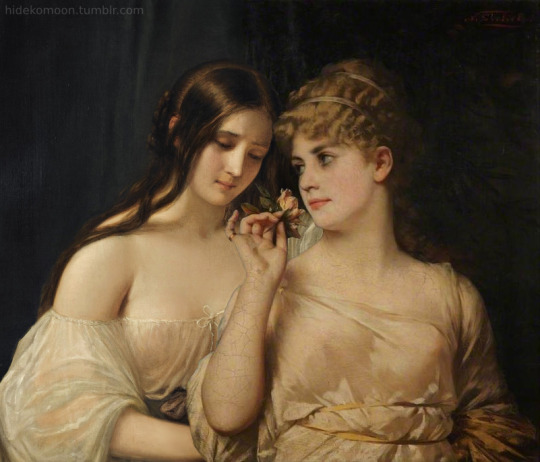
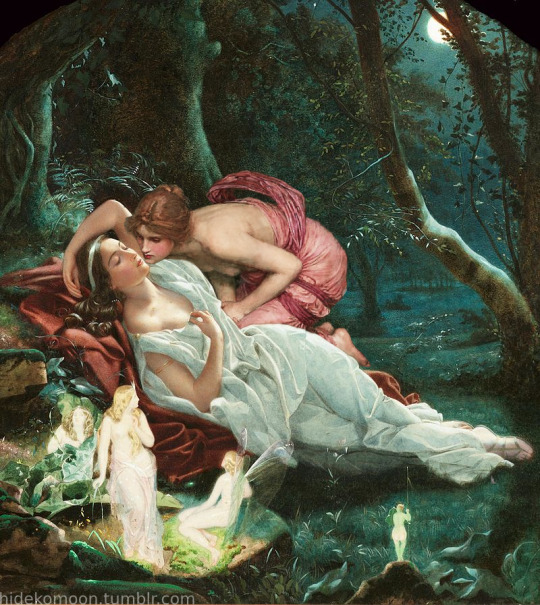
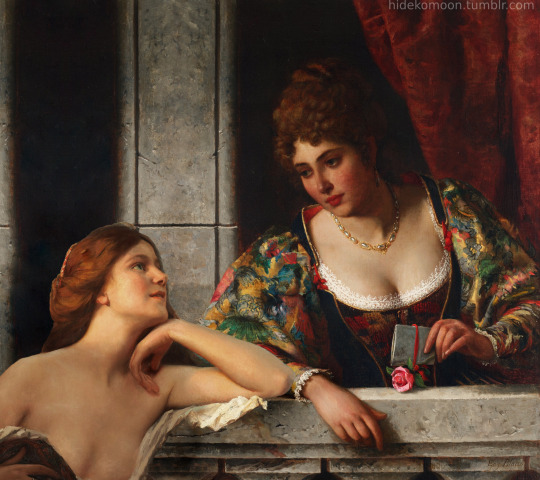
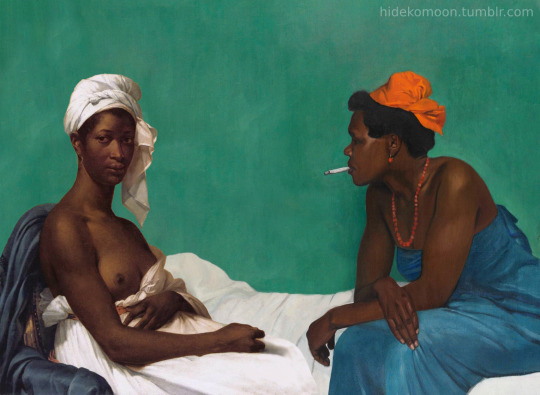
i finished the first 3 last spring and then completely gave up on this project until i completed number 4 & 5 this week. i’m kind of running out of paintings with easy poses to photoshop together but i’m gonna keep looking! (here’s my little collection of lesbian montages)
1. Evelyn de Morgan’s The Prisoner (1907-08) with Joanna Mary Boyce’s portrait of Fanny Eaton (1859)
2. Waterhouse’s The Awakening of Adonis (c.1900) and John Simmons’s Titania Sleeping in the Moonlight Protected by her Fairies
3. Portrait of a Lady by Natale Schiavoni (c.1820) with Nathaniel Sichel’s In the Time of Roses
4. A painting by Eugene de Blaas and L’Espoir by Auguste Leroux
5. La Blanche et la Noire by Félix Valloton (1913) with Portrait of Madeleine by Marie-Guillemine Benoist (1800)
#medievalcore#painting#mine#lesbian#wlw#art history#evelyn de morgan#john william waterhouse#waterhouse#fanny eaton#joanna mary boyce#pre raphaelite#academism#classical#mythology#sapphic#the first one is my favorite montage i've ever done tbh. boyce's portrait of fanny eaton is just perfect
228 notes
·
View notes
Text

Study of Fanny Eaton (1835-1924), by Joanna Boyce Wells (1831-1861) 1859.
5 notes
·
View notes
Text
Fanny Eaton (1835-1924) was the daughter of a slave, born just after the abolition of slavery and brought to England by her mother. Fanny had two children and worked as a domestic servant and as an artist's model at the Royal Academy of Arts. Simeon Solomon featured Eaton in his painting, The Mother of Moses, and she was a favourite subject for the Pre-Raphaelite artists. This chalk drawing is by Walter Fryer Stocks c.1859.
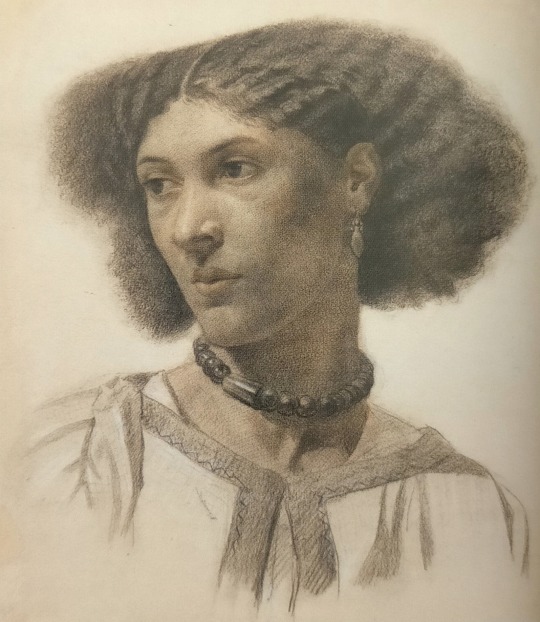
"Normal Women: 900 Years of Making History" - Philippa Gregory
#book quotes#normal women#philippa gregory#nonfiction#fanny eaton#abolition#slavery#england#domestic servitude#artist model#royal academy of arts#simeon solomon#the mother of moses#pre raphaelite#chalk drawing#walter fryer stocks#50s#1850s#19th century
7 notes
·
View notes
Text
youtube
youtube
#lindsay holiday#tea time with lindsay holiday#history#louise marie therese#ignatius sancho#joseph bologne#olaudah equiano#dido elizabeth belle#jean amilcar#alexandre dumas#Youtube#sara forbes bonetta#ira aldridge#mary seacole#pablo fanque#fanny eaton#samuel coleridge taylor#alemayehu of ethiopia
5 notes
·
View notes
Text
Simeon Solomon

Fanny Eaton (1835–1924) Simeon Solomon (1840–1905) The Fitzwilliam Museum
175 notes
·
View notes
Note
Madame Marzi I must defer to ur wisdom
Recently you rb’d a painting with some younger ladies and in the tags talked a bit about short hair in Victorian Times
Do you have any reference for how shorter hair was styled at the time? I’ve seen plenty of paintings and such with VERY short hair (post illness or perhaps childbirth) where all you can really do is smooth it back, but what about that awkward, past the shoulders sort of stage where it’s too long to just brush back but too short to do much to? Surely they had some styling guides..?
(Also, a side question— how old would one be before going from shorter skirts to adult/full length ones?)
The two little girls in the garden (probably preteens-young teens)? Yes, I did!
It's hard to find images of women with in-between hair lengths, and I'm not sure why. Possibly because they'd find ways to put it up with false hair, whereas hair too short to put up is more obvious in photos. This could also have to do with the type of woman who has pixie- or bob-length hair voluntarily vs. mid-length: the latter is more likely to be attempting a grow-out, and thus to try her darndest to do The Culturally Accepted Long Hair StylesTM where a lady who chose a much shorter look wouldn't care. If that makes sense? Because, indeed, some of the women with very short hair were not ill or postpartum: ladies could, and did, choose to eschew long locks back then. It wasn't very common, but it happened.
(Nicole Rudolph has an excellent video about localized short hair trends for ladies during the Victorian era.)
You see a lot of these bob-type looks in photographs where the hair is center-parted and either naturally curly or curled on purpose, around the mid-19th century:
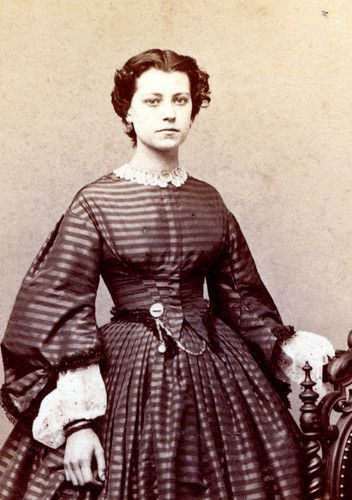
(1850s or 60s)
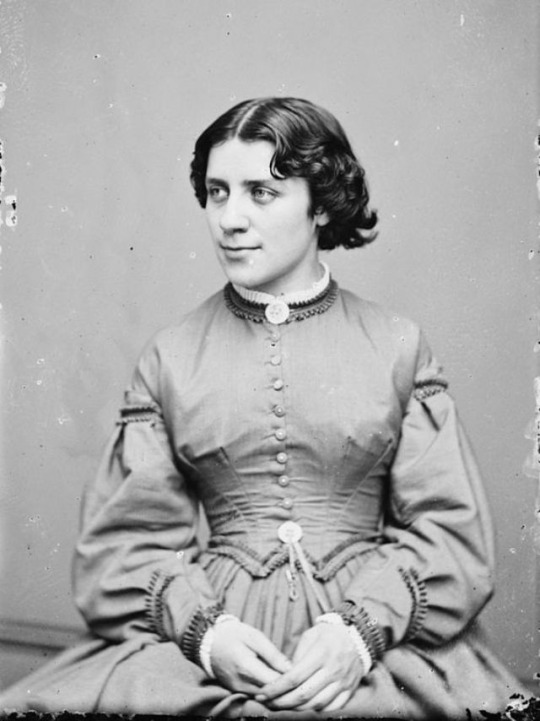
(Author, feminist, and abolitionist Anna Elizabeth Dickinson- no relation to Emily that I know of, though Anna was also a queer female writer around the same era -c. 1860s. She wore her hair short all her life, so it was voluntary in this case.)
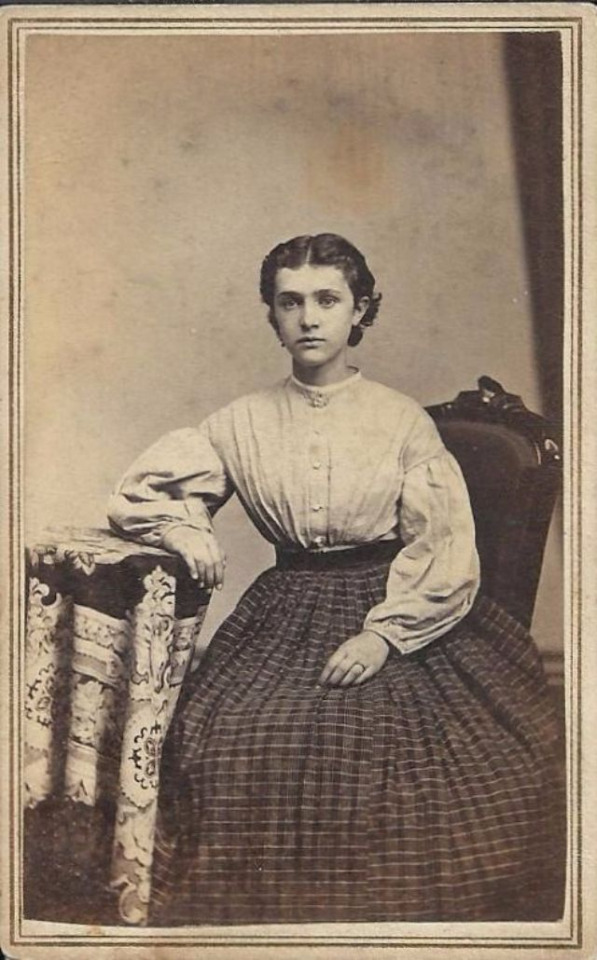
(Also 1860s.)
Pre-Raphaelite muse Fanny Eaton frequently appears to have chin-to-shoulder length hair, though given that she was Black with a corresponding hair texture, it's hard to tell what the actual length is- it may be long and looped up in the 1850s-60s styles popular when she was most commonly painted (most free Black women in England and the US wore styles also popular with white women, to the best of their abilities given that fashion plates assumed European-textured hair as the "norm"):
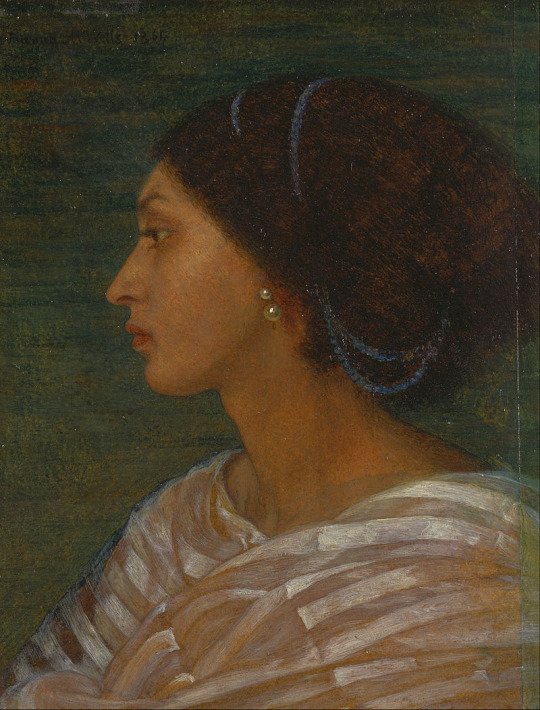
(Fanny Eaton, 1861. Also worth noting that we have no images of what her hair looked like when she wasn't posing for fantastical paintings.)
I've never actually seen an image of a Victorian woman with mid-length hair outside the context of theatrical or artistic images from the end of the century, now I think of it. Huh. It's a mystery, I suppose!
As for skirts, while in earlier periods children had basically worn miniature adult clothing, it became fashionable around the 1830s-40s to dress girls in short skirts and boys in short pants. The usual rule was knee-length until around age 10, then mid-calf-length until somewhere between 16 and 18 when skirts would be "let down" and the girl would start wearing her hair up, becoming a young adult in the eyes of society. (Contrary to popular belief, this had nothing to do with marriage- while you were theoretically eligible for it when you started dressing as an adult, girls/women younger than 20 were still often considered a bit too immature to marry. It wasn't forbidden, but many people thought it unwise. And yes, unmarried young women did still wear their hair up and their skirts long.)
...unless she preferred her hair short, which as you can see, was an option!
92 notes
·
View notes
Text

The Mother of Moses
Artist: Simeon Solomon (British, 1840–1905
Date: 1860
Medium: Oil on canvas
Collection: Delaware Art Museum, Wilmington, Delaware, United States
Description
Moses's mother Jochabed is seen here holding her infant, the baby Moses, before consigning him to the river Nile in the wicker basket, which the baby's elder sister, Miriam, has under her arm. Jochabed has kept the child hidden but now accepts that she must act more drastically if he is to escape the Pharoah's edict that baby boys should be taken from their families and drowned: "when she could not longer hide him, she took for him an ark of bulrushes, and daubed it with slime and with pitch, and put the child therein; and she laid it in the flags by the river's brink" (Exodus 2,3).
Solomon has tried to present the heart-breaking moment with Pre-Raphaelite accuracy. This included using the Jamaican-born Fanny Eaton as his model — the baby and the girl are likely to have been her own children.
#painting#interior scene#biblical scene#oil on canvas#christianity#fine art#jochabed#miriam#infant moses#basket#old testament#book of exodus#christian art#pre raphaelism#simeon solomon#british culture#oil painting#holy bible#pre raphaelite painter#british art#delaware art museum#artwork#19th century painting
23 notes
·
View notes
Text

Mrs Eaton—Dante Gabriel Rossetti
#dante gabriel rossetti#black chalk#chalk#chalk art#charcoal#pre raphaelite#pre raphaelism#bit of a#the sandman#tie-in#how they met themselves#queue crew
5 notes
·
View notes
Text
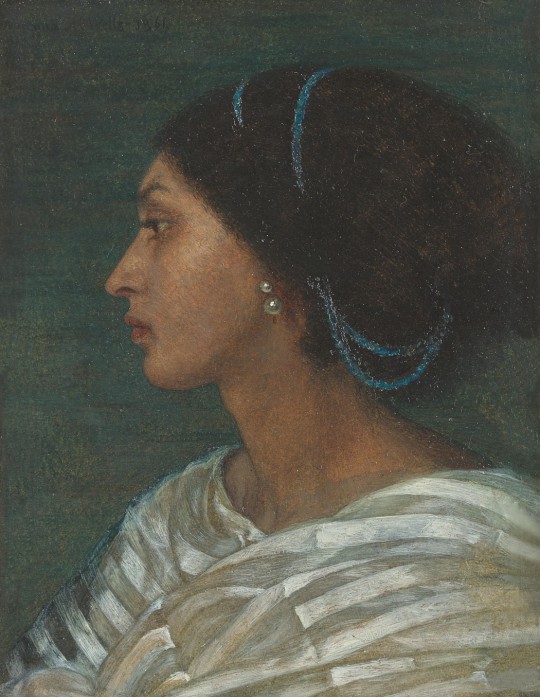
Joanna Boyce Wells Study of Fanny Eaton, 1861. Oil on paper laid to linen
42 notes
·
View notes
Photo
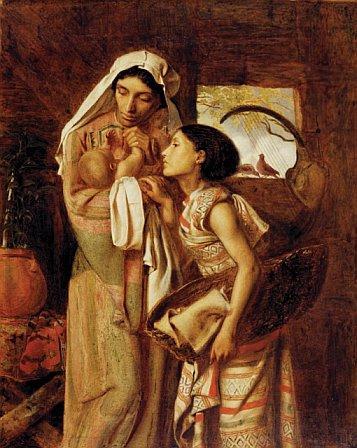
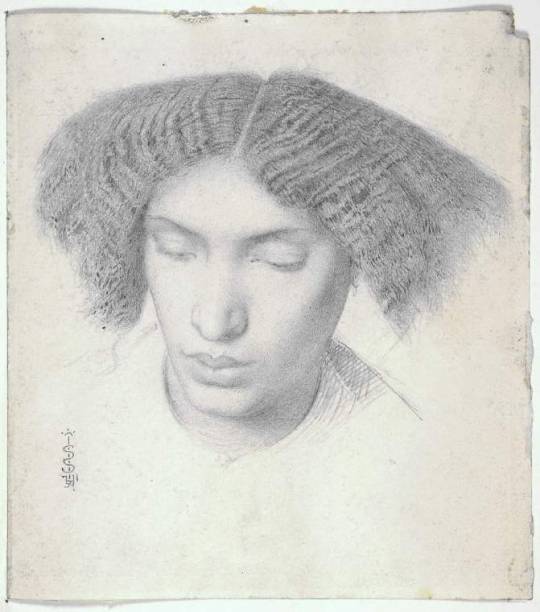



Simeon Solomon, The Mother of Moses (1860), and studies of Fanny Eaton (1859) for Yocheved and Miriam
Screencaps or Yocheved and Miriam from Prince of Egypt (1998)
140 notes
·
View notes
Note
i feel like i'm missing something i get why margot is a bad choice but how does an actor have "gothic" vibes? is this like a period drama face thing
I suppose it's similar, but there's definitely an aesthetic that comes with gothic romance. I would recommend looking up paintings like "Emma Hart as Circe" (this was used as the WH cover in some mass market editions) and the Pre-Raphaelites. Rossetti, Waterhouse, models like Fanny Eaton and Elizabeth Siddal, Jane Morris.
There's an aesthetic that to me looks less carved and chiseled and more lush and "melting into nature" associated with Romanticism (which, in a work like Wuthering Heights, makes Catherine's withering away all the more stark). WH is a work that is inherently aligned with nature, because it's Gothic and it's Romantic.
Again, would never say that Margot isn't beautiful, but I think that a lot of people understandably have more of an idea of that sort of untamed, wild-haired, full-faced, sort of untouched beauty turned fallen woman with Cathy.
FWIW, in her Borgias days especially I think Holliday Grainger also would've been a great match for this type of role, for similar reasons. There's something a lot less chiseled to her look, and this isn't to say that someone like Margot can't be in a period piece (I mean, Keira K has a chiseled~ face and was a period piece queen) but for Cathy I wouldn't choose someone who looks so polished.
7 notes
·
View notes
Text

Fanny Eaton-Antwistle the first Jamaican supermodel of Notting Hill, who came to Britain in the 1840s, married James Eaton and lived at 191 Lancaster Road in the 1860s-70s. She modelled at the Royal Academy and became closely associated with the Pre-Raphaelites. She features in paintings by Everett Millais, Frederick Sandys and Dante Gabriel Rossetti. Sourced by David Fitzgerald from https://www.cityoflondon.gov.uk/.../unforgotten-lives...
https://www.cityoflondon.gov.uk/.../unforgotten-lives
17 notes
·
View notes
Text
FANNY EATON // ARTIST MODEL
“She was a Jamaican-born artist’s model and domestic worker. She is best known as a model for the Pre-Raphaelite Brotherhood and their circle in England between 1859 and 1867. Her public debut was in Simeon Solomon’s painting The Mother of Moses, which was exhibited at the Royal Academy in 1860. She was also featured in works by Dante Gabriel Rossetti, John Everett Millais, Joanna Mary Boyce, Rebecca Solomon, and others.”


5 notes
·
View notes
Text
Dive into the story of Fanny Eaton, the Pre-Raphaelite model! Born in Jamaica in 1835, she arrived in England as a child and later became a muse for the Pre-Raphaelite Brotherhood, a prominent group of English painters. Today, Fanny's portraits grace the Tate, the Delaware Art Museum, and Stanford University in California. Uncover her inspiring life in this 60-second video! 🖼️
9 notes
·
View notes
Text

Simeon Solomon, Fanny Eaton, 1860 x
1 note
·
View note
